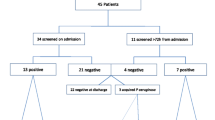Abstract
The prospective cohort study presented here assessed the risk factors associated with Pseudomonas aeruginosa gastrointestinal colonization (PAGIC) in 933 patients hospitalized in five different wards in a French university hospital. A total of 195 patients were colonized. By logistic regression, hospitalization in an intensive care unit and length of hospital stay were independent risk factors. A significant association was observed between fluoroquinolone use and PAGIC caused by an ofloxacin-resistant strain (p<0.0001), imipenem use and PAGIC caused by an imipenem-resistant strain (p<0.0002) and ceftazidime use and PAGIC caused by a ceftazidime-resistant strain (p<0.02). The ecological impact of antibiotic use is of great clinical relevance and clinicians should consider antimicrobial resistance in order to limit the development and dissemination of resistant microorganisms.
Similar content being viewed by others
References
Hawkey PM (1998) Action against antibiotic resistance: no time to lose. Lancet 351:1298–1299
Defez C, Fabbro-Peray P, Bouziges N, Gouby A, Mahamat A, Daures JP (2004) Risk factors for multidrug-resistant Pseudomonas aeruginosa nosocomial infection. J Hosp Infect 57:209–216
Leroy O, d’Escrivan T, Devos P, Dubreuil L, Kipnis E, Georges H (2005) Hospital-acquired pneumonia in critically ill patients: factors associated with episodes due to imipenem-resistant organisms. Infection 33:129–135
Kang CI, Kim SH, Park WB, Lee KD, Kim HB, Oh MD, Choe KW (2005) Risk factors for antimicrobial resistance and influence of resistance on mortality in patients with bloodstream infection caused by Pseudomonas aeruginosa. Microb Drug Resist 11:68–74
Blanc DS, Petignat C, Janin B, Bille J, Francioli P (1998) Frequency and molecular diversity of Pseudomonas aeruginosa upon admission and during hospitalization: a prospective epidemiologic study. Clin Microbiol Infect 5:242–247
Bodey GP (1970) Epidemiological studies of Pseudomonas species in patients with leukemia. Am J Med Sci 260:82–89
Murthy SK, Baltch AL, Smith RP, Desjardin EK, Hammer MC, Conroy JV, Michelsen PB (1989) Oropharyngeal and fecal carriage of Pseudomonas aeruginosa in hospital patients. J Clin Microbiol 27:35–40
Sullivan A, Edlund C, Nord CE (2001) Effect of antimicrobial agents on the ecological balance of human microflora. Lancet Infect Dis 1:101–114
Filius PM, Gyssens IC, Kershof IM, Roovers PJ, Ott A, Vulto AG, Verbrugh HA, Endtz HP (2005) Colonization and resistance dynamics of gram-negative bacteria in patients during and after hospitalization. Antimicrob Agents Chemother 49:2879–2886
Richard P, Delangle MH, Raffi F, Espaze E, Richet H (2001) Impact of fluoroquinolone administration on the emergence of fluoroquinolone-resistant gram-negative bacilli from gastrointestinal flora. Clin Infect Dis 32:162–166
Carsenti-Etesse H, Cavallo JD, Roger PM, Ziha-Zarifi I, Plesiat P, Garrabe E, Dellamonica P (2002) Effect of beta-lactam antibiotics on the in vitro development of resistance in Pseudomonas aeruginosa. Chirurgia 97:151–159
Zavaski AP, Cruz RP, Goldani LZ (2005) Risk factors for imipenem-resistant Pseudomonas aeruginosa: a comparative analysis of two case–control studies in hospitalized patients. J Hosp Infect 59:96–101
Bergmans DC, Bonten MJ, van Tiel FH, Gaillard CA, van der Geest S, Wilting RM, de Leeuw PW, Stobberingh EE (1998) Cross-colonization with Pseudomonas aeruginosa of patients in an intensive care unit. Thorax 53:1053–1058
Weist K, Pollege K, Schulz I, Ruden H, Gastmeier P (2002) How many nosocomial infections are associated with cross-transmission? A prospective cohort study in a surgical intensive care unit. Infect Control Hosp Epidemiol 23:127–132
Bertrand X, Thouverez M, Talon D, Boillot A, Capellier G, Floriot C, Hélias J (2001) Endemicity, molecular diversity and colonization routes of Pseudomonas aeruginosa in intensive care units. Intensive Care Med 27:1263–1268
Acknowledgments
The authors thank G. Potel and N. Asseray from the medical ward, M. Pinaud and D. Demeure from the surgical ICU, D. Villers from the medical ICU, J.-Y. Lepage from the urology ward, and C. Dubois and G. Bon from the physical medical and rehabilitation department for authorization to study the patients.
Author information
Authors and Affiliations
Corresponding author
Rights and permissions
About this article
Cite this article
Lepelletier, D., Caroff, N., Riochet, D. et al. Role of hospital stay and antibiotic use on Pseudomonas aeruginosa gastrointestinal colonization in hospitalized patients. Eur J Clin Microbiol Infect Dis 25, 600–603 (2006). https://doi.org/10.1007/s10096-006-0184-1
Published:
Issue Date:
DOI: https://doi.org/10.1007/s10096-006-0184-1




